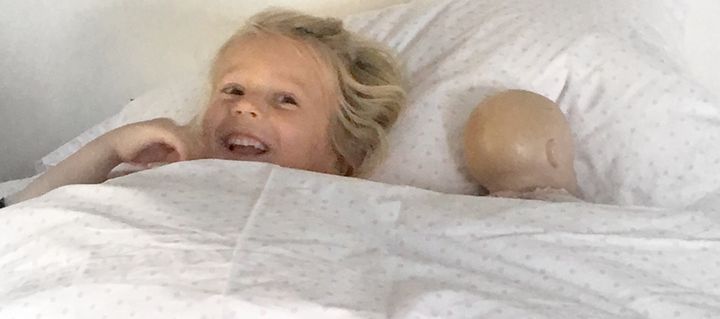While you may be itching to redecorate your baby’s nursery into a big kid room because you are bored with the baby color scheme, don’t jump the gun too soon! Moving into a bed without barriers can turn a great sleeper into a jack in the box overnight!
Here’s how to determine how and when the time is right to switch to a big kid bed and satisfy your redecorating urge.

- Time it right: Wait until at least age 3, and preferably age 4. Why? Children under age 3 have difficulty understanding imaginary boundaries. The sides of the crib keep them safe and contained! If you make the change too early, prepare for night wakings and wandering, and perhaps an unwanted nighttime visitor in your bed!
- Climbing out of the crib is not necessarily a reason to transition to a bed. You may have a ninja on your hands, as many 2-year-olds are, but don’t let her ability to scale the crib spur you to rush the transition.
Try these tips first:
- Put on a sleep sack to make it more difficult to scale the crib. Several brands like Woolino make larger sizes for older children. You may even have to put it on backwards if you have a Houdini on your hands.
- Turn the crib around. If your crib has one side with higher bars, turn it so the higher side faces outward. This usually makes escape difficult for even for the most agile climbers. You may even have to move other pieces of furniture near the crib to prevent exits out of the sides.
- Lower the mattress to the floor if possible. This usually makes it impossible even for tall toddlers to climb out. Lining a gap with swim noodles can make it safe.
- Use a video monitor to catch your child in the act of climbing and run into the room (or talk through the monitor) as they are climbing out and sternly say “No!”. This method is extremely effective if you can catch them in the act. You may need to repeat multiple times before they get the message.
3. Make a big deal about the transition once your child is ready: Moving to a bed should be a reward for great sleep habits when the time is right. Take your child shopping for some new sheets or even a bed, and a cuddly stuffed animal to snuggle with in his new big boy bed.
4. Establish sleep rules. Have fun making a bedtime routine poster that your child can decorate. As you are making the poster, give her choices about what her routine looks like: “Do you want two books or three?” “Do you want to put your PJs on before or after you brush your teeth?” The more choices you allow, the more likely she will comply and feel independent. The last rule should be “I stay quiet in bed until my clock tells me it’s okay to wake or until Mommy and Daddy get me.” Using a toddler clock or simple alarm clock are helpful visual reminders of the right time to wake. Instead of words, take pictures of your child doing the steps of the routine, so that your toddler can easily follow the routine by consulting the poster as a guide. Set firm limits around “extras” and read more toddler sleep tips here.
5. Time bedtime accurately: A bedtime that is too late, or too early, can result in more bedtime antics at this age. By age 3-4, bedtime should be about 4.5-5 hours after the end of the nap or, if there is no nap, about 12 hours after wake time. This usually means bedtime is between 6-7:30 p.m. depending on nap length. Leave enough time for a relaxing 15-20 minute bedtime routine (read books; made up stories; talk about the day; sing songs) before final kisses and hugs and leaving the room.
6. Have a plan if your child escapes! Return your child to bed silently and consistently so the behavior is not rewarded. Be prepared to repeat several times before she gets the message. Read more tips on how to contain your jack in the box here.
7. Make your child’s room safe. Ensure furniture is attached to the wall and there is no way he can hurt himself once is is free to roam on his own. Sometimes removing books and toys is helpful so there are less distractions.
For sleep tips on how to help your toddler fall asleep easily and sleep through the night, read this.
If you have an early riser and need more sleep, read this for easy solutions.